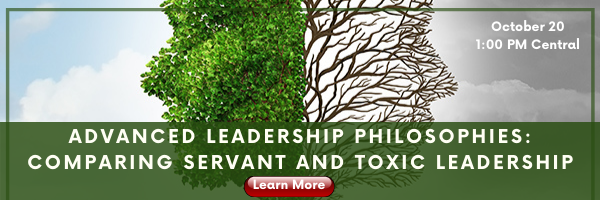Are you like many leaders, or aspiring leaders, and ask yourself, What kind of leader am I? Or do you wonder about the type of leader you want to be? If so, you most likely have consulted many of the published websites, books, and models that exist to answer these essential questions. In this search, you have probably reviewed Bass and Avolio’s full range of leadership model. The full range of leadership model compares transactional to transformational leadership styles based on the types of behaviors leaders exhibit (Bass & Avolio, 1994). The model argues transformational leadership is what we should aspire to practice as leaders.
However, many leadership scholars and researchers, including myself, would argue this popular model does not truly capture the full range of leadership. Precisely, the model does not capture the potential serving aspect of leadership, nor is there any mention of toxic leaders. I argue, based on my research, understanding these two powerful types of leadership is critical in understanding leadership. Furthermore, leaders should understand servant leadership and toxic leadership to truly comprehend the influence they have on their followers. To assist with this knowledge, I provide a quick overview of both types of leadership.
Servant Leadership
Robert Greenleaf created the term servant leadership to define a distinct leadership philosophy. Servant leaders are leaders who want to serve others and view leadership as a way they can serve in a greater capacity (Greenleaf, 1990). Servant leaders strive to improve the lives of those in their care and influence their lives in positive ways. Specifically, Greenleaf (1990) offered a “best test” for servant leadership by sharing that the followers of servant leaders would be more autonomous, healthier, wiser, and more likely to serve themselves. In other words, servant leaders create environments where their followers can grow.
Common behaviors of servant leadership include:
- Being honest, trustworthy, authentic, and humble;
- Leading in a way that allows followers to grow;
- Expressing care and concern for followers;
- Listening deeply and honestly to understand;
- Valuing and encouraging collaboration;
- Creating and articulating a shared connection;
- Utilizing systems-thinking to connect systems with ethical issues and challenges; and
- Leading with moral authority and ethical bounds (Sipe & Frick, 2015).
Toxic Leadership
Toxic leaders are leaders who engage in behaviors that are damaging to their followers (Lipman-Blumen, 2005). Toxic leaders are more concerned with power, prestige, and their image than doing what is right for others or an organization (Burns, 2017). As a result, toxic leaders leave followers worse than when they found them. Specifically, toxic leaders influence their followers in many negative ways. The current research shows the followers of toxic leaders are typically less satisfied with their jobs, experience higher levels of stress, experience health and emotional ailments, and are more likely to engage in counterproductive workplace behaviors themselves. In other words, toxic leaders create environments where their followers are harmed and, as a result, typically do not grow.
Common behaviors of toxic leadership include:
- Ridiculing followers and telling them (or others) they are incompetent;
- Being inconsiderate of followers’ commitments outside of work;
- Controlling how followers complete tasks;
- Making all decisions within a team whether they are important or not;
- Believing they are more capable than others;
- Denying responsibility for mistakes and accepting credit for successes of others;
- Having explosive outbursts and varying in their degree of approachability; and
- Pitting others against one another (Schmidt, 2008).
Comparing and contrasting servant leadership and toxic leadership
The prior two sections outlined two powerful types of leadership: servant leadership and toxic leadership. I contend these two types of leadership are opposing types of leadership. Servant leaders choose to lead because of their desire to serve and help others (Greenleaf, 1990). These leaders put others first through mentoring followers, involving them in decisions, and by sharing power and control. Because of these actions, the followers they serve grow as individuals.
On the other hand, toxic leaders are compelled to lead by their ego (Lipman-Blumen, 2005; Schmidt, 2008). Toxic leaders want others to see them as powerful and important. Because of this, these leaders will manipulate, coerce, and abuse followers to achieve this goal. As a result, toxic leaders’ followers are hurt or damaged, which I argue is the exact opposite of what happens to the followers of servant leaders.
Why understanding these opposing types of leadership is important
I argue, like many leadership researchers, that knowing all facets of leadership is essential when determining what kind of leader you are or want to be. Likewise, I contend studying the “traditional” types of leadership is not enough as often two of the most influential types of leadership are missed. Specifically, servant leadership and toxic leadership are powerful forms of leadership. These two types of leadership amplify something we too often miss when discussing leadership: the influence on the followers.
A key component of servant leadership is the growth of followers. Meaning, servant leaders are supposed to help followers grow. In toxic leadership, the followers, as the current literature shows, are harmed in numerous ways. I argue and contend we, as leaders or aspiring leaders, need to understand these two types of leadership to truly understand our power. Specifically, leaders influence the lives of their followers. Servant leaders do so in a positive way, while toxic leaders negatively influence their followers’ lives. Thus, we need to recognize these influences to be able to understand the power we have as leaders and, hopefully, understand how we can use this power for good. Without this knowledge, how can we truly understand what it means to be a leader?
Join Stephanie Hinshaw on Tuesday, October 20 at 1:00 PM Central for her live, online seminar, Advanced Leadership Philosophies: Comparing Servant and Toxic Leadership
Stephanie Hinshaw, EdD, MBA, is the senior vice president of Academic Affairs at American College of Education. Hinshaw considers leadership development one of her primary accountabilities in her role. Her research centers around the long-term influences of toxic leaders on their followers.
References
Bass, B. M., and Avolio, B. J. (1994). Improving organizational effectiveness through transformational leadership. Sage Publications.
Burns, W. A., Jr. (2017). A descriptive literature review of harmful leadership styles: Definitions, commonalities, measurements, negative impacts, and ways to improve these harmful leadership styles. Creighton Journal of Interdisciplinary Leadership, 3(1), 33-52. https://doi.org/10.17062/cjil.v3i1.53
Greenleaf, R. K. (1990). The servant as leader. Greenleaf Center for Servant Leadership.
Keith, K. M. (Ed.). (2016). The contemporary servant as leader. Greenleaf Center for Servant Leadership.
Lipman-Blumen, J. (2005). The allure of toxic leaders. Oxford University Press.
Schmidt, A. A. (2008). Development and validation of the Toxic Leadership Scale, Master’s thesis, University of Maryland. https://hdl.handle.net/1903/8176
Sipe, J.W., & Frick, D.M. (2015). Seven pillars of servant leadership: Practicing the wisdom of leading by serving. Paulist Press.







